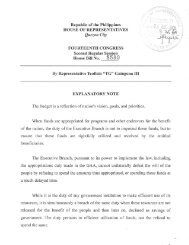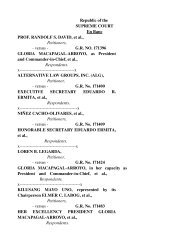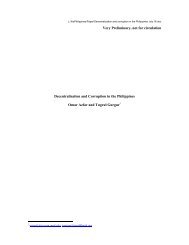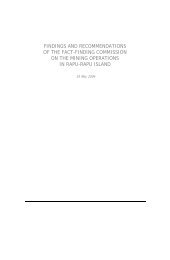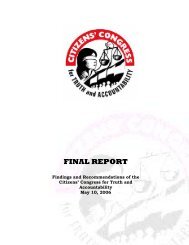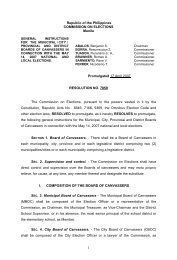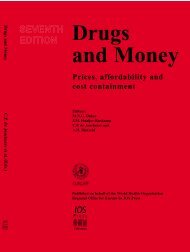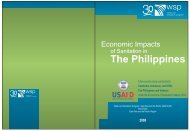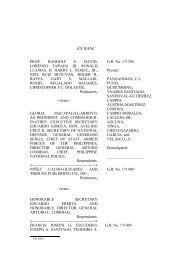i Report Issue No. 3 2005 - Philippine Center for Investigative ...
i Report Issue No. 3 2005 - Philippine Center for Investigative ...
i Report Issue No. 3 2005 - Philippine Center for Investigative ...
You also want an ePaper? Increase the reach of your titles
YUMPU automatically turns print PDFs into web optimized ePapers that Google loves.
FOCUS ON FILIPINO YOUTH<br />
SAMIRA GUTOC<br />
BEFORE ME<br />
was an Islamic<br />
religion studies graduate, an al-<br />
eema<br />
who divorced her<br />
aleem<br />
(Islamic learned man) husband<br />
<strong>for</strong> beating her up. She was<br />
lecturing on significant Muslim<br />
women in Islamic history. So far<br />
she had taken up the Prophet<br />
Muhammad’s wife Khadija<br />
and daughter Aisha. Today’s<br />
topic: Madina’s Umu Sulaim<br />
Rumaisa. All were women of<br />
virtue whose lives could give<br />
us insights on what a Muslim<br />
woman should aspire to.<br />
Every Sunday, a few of us<br />
women and girls in the barrio<br />
would gather in a small shop<br />
of a lady leader to read the<br />
Qur’an and listen to aleemas,<br />
who would arrive garbed in<br />
traditional dress, with only their<br />
eyes peering out of their veils.<br />
But once they were in front of<br />
us, they would shed their facial<br />
covering and discuss themes<br />
ranging from women heroes to<br />
marriage and women’s obligations—basically<br />
all things domestic.<br />
Through an association<br />
of women “seeking faith,” the<br />
seminars provided us a place<br />
to rest, as well as to bond and<br />
learn with other women.<br />
My village at Buadi Sacayo,<br />
one of the homes of the old<br />
sultanates, has held on to many<br />
traditions. It is a close-knit community<br />
where residents, especially<br />
the young, congregated in the<br />
street or during Friday prayers.<br />
People here are proud of their<br />
roots, a pride they made evident<br />
through their colorful homes<br />
decorated in the traditional style.<br />
Across this village, at the other<br />
end of the highway, is Mindanao<br />
State University (MSU),<br />
where the more Western-educated<br />
reside and teach. While my<br />
barrio provides spiritual congregation,<br />
it is on the secular, modern<br />
campus that I meet a host<br />
of other highly educated and<br />
“modern” women. Our most<br />
recent topic was women’s rights<br />
and all the rah-rah of promoting<br />
it. The context: cleaning up the<br />
elections, especially the ARMM<br />
polls in August.<br />
Despite living away from<br />
the metropolis <strong>for</strong> the past year,<br />
I find staying in the Islamic<br />
city of Marawi refreshing <strong>for</strong><br />
I see the best of two worlds:<br />
those who gave up on the old<br />
ways and those who live it. At<br />
one end is the sandal-and-backpack<br />
crowd, people who live<br />
on just the basics and whose<br />
ultimate activity is prayer. At<br />
the other end are those who<br />
push <strong>for</strong> material success and<br />
crave recognition—the professionals,<br />
politicians, and yes,<br />
NGO workers. One fact ties<br />
each extreme to each other:<br />
both are made up of Muslims.<br />
I myself feel I am between<br />
both worlds. Sometimes, I even<br />
feel like an interloper. Having a<br />
hijab (veil) on and having non-<br />
Muslim friends makes me feel<br />
half-Muslim and half-Christian<br />
(or mestiza). It is not the religion<br />
that makes me feel like I always<br />
have to be in the middle of a<br />
religious discourse. Instead the<br />
feeling arises from the curiosity/<br />
half-acceptance I encounter in<br />
both Muslim and Christian circles.<br />
When I am with Muslims, I<br />
have to defend my “liberal” media<br />
profession. When I am with<br />
Christians, I have to explain<br />
Islam’s practices.<br />
But what is being Muslim<br />
anyway? Was it all about the<br />
five pillars, about the sayings<br />
of the Prophet and the<br />
Qur’an? What of the women,<br />
like me—had we rights, could<br />
we speak out? And how about<br />
pop music, my favorite, was it<br />
haram<br />
(<strong>for</strong>bidden)? Was living<br />
all about following rules?<br />
These were among the questions<br />
I had while growing up,<br />
and I have been asking even<br />
more questions since. I had been<br />
brought up to be conscious of<br />
my heritage, to always protect<br />
our maratabat, our good name,<br />
to avoid overexposure to the<br />
outside world. This was my culture<br />
as a Maranao. My religion, at<br />
least as taught to me, said almost<br />
the same thing—to observe the<br />
rituals, to lead a structured life.<br />
But I have since realized that<br />
religion is actually dynamic and<br />
that it was only the elders who<br />
had interpreted it otherwise.<br />
As postmodernist author Akbar<br />
Ahmed says, Islam and balance<br />
are compatible, meaning Muslims<br />
are not prohibited from embracing<br />
principles such as tolerance,<br />
democracy, and justice. So<br />
could a Muslim have a Christian<br />
as a best friend? Can we sing and<br />
dance? Could Muslim women<br />
wear jeans? And how do we see<br />
the Pope and Madonna?<br />
I THINK Muslim communities<br />
have yet to confront questions<br />
Growing<br />
Fema<br />
&<br />
Mus<br />
52 PHILIPPINE CENTER FOR INVESTIGATIVE JOURNALISM I REPORT



